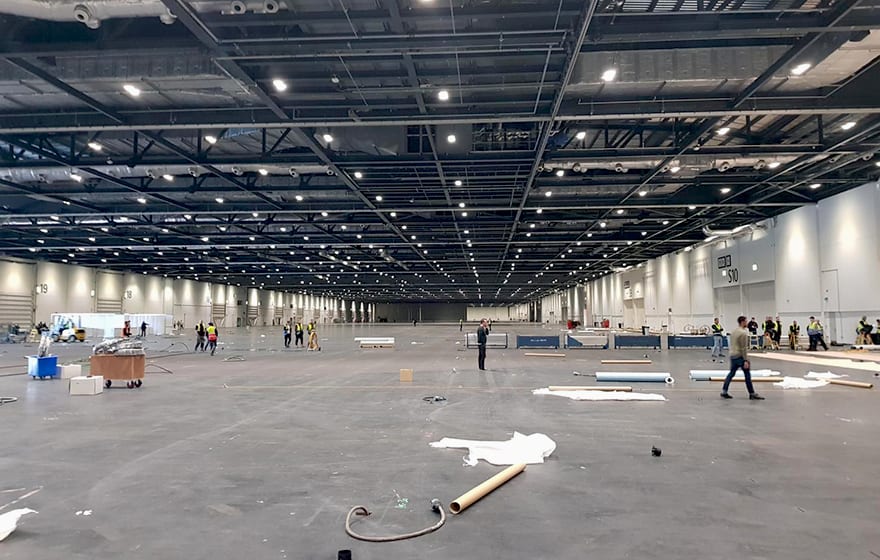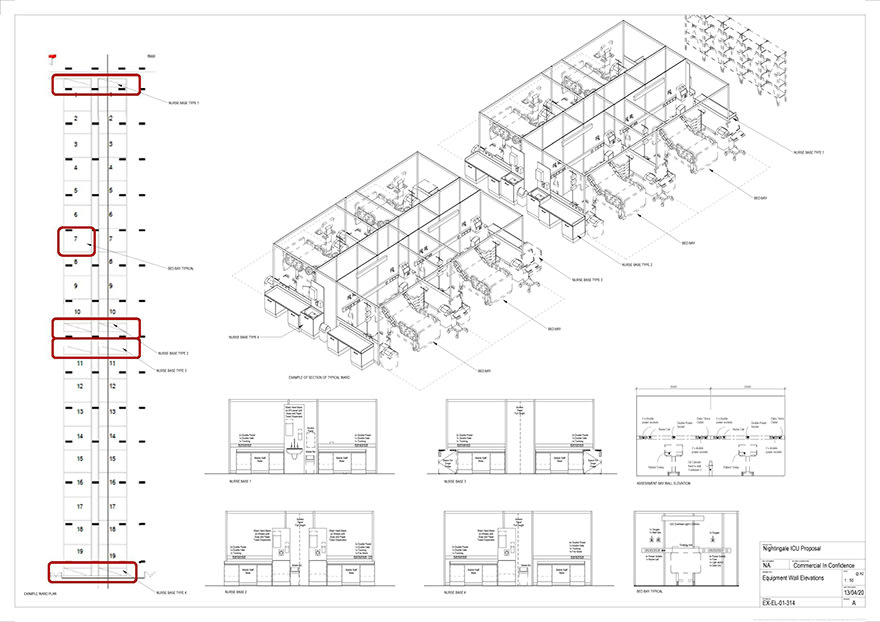- Client: Barts Health NHS Trust, Royal Free London NHS Foundation Trust
- Lead Contractor: Lead Designer: BDP
- BIM Tools: Autodesk Revit
The UK’s newest and largest hospital, based at the ExCeL conference centre in London’s Docklands, is designed to care for up to 4,000 people affected by Covid-19. The hospital is now in standby mode and will be used should cases in the London area rise again.
The conversion of the centre into a hospital – a process rolled out in other buildings around the country – has provided lessons more generally for how the industry might operate.
The building’s double exhibition halls are fitted out with a framework for about 80 wards, each with 42 beds, of which some 500, with oxygen and ventilators, are already in place.
With an incredibly tight timeframe for construction, BDP developed a fully-functional BIM model, used to coordinate the design team, in just three days.
The architect was responsible for internal space and clinical planning, while engineering consultancy Mott McDonald prepared the site wide strategy. Both worked in close contact with principal contractor CFES and the Royal Anglian Regiment and Royal Gurkha Rifles, who would construct the facility in record time.
The project was a true design and build, with construction underway almost the instant designs were put to paper. The process was intense and tiring, but also rewarding, says Jordon Lambert, architect at BDP: “We took quite a freeform approach to collaboration, everyone had a linear perspective and knew what the brief was and why the job was so important. That enabled us to work as a true design team collective, it has been a great experience.”

The sheer size of ExCel and its use as a temporary venue for exhibitions and events made it ideal to reconfigure as a field hospital
BDP’s team was split into two, working in Revit. One side developed the high level space planning, the other focused on clinical planning and requirements for critical care beds, nurse stations, admissions etc.
The two models were combined to create a central BIM model ready to be populated with data from other consultants and schedule equipment and materials.
“Data from architecture, M&E and lighting were all fed into the central model, BDP was responsible for issuing information to the wider design team,” says Lambert. “Some firms worked in Revit, others used formats including 2D CAD and fed information to us to populate the model.”
BDP had a pre-existing library of Revit families for hospitals and, in collaboration with clinicians, tailored the information to meet the needs of the brief and ensure compliance with statutory standards.
There was a heavy focus on modular design to mitigate risk, maximise efficiency and minimise waste. A “kit of parts” steel framework used to build exhibition stands was reappropriated to create individual bed bays because it is lightweight and fast to erect.
The specific dimensions of the steel and partitions were replicated in Revit families, which in turn informed the dimensions for beds and equipment. “The ability to plug that information into BIM was very valuable and enabled the team to quickly mobilise and build the spaces, while in parallel we developed other aspects of the design,” says Lambert. Other healthcare equipment and specialist partitions required for infection control were procured separately.

BDP had a pre-existing library of Revit families for hospitals and, in collaboration with clinicians, tailored the information to meet the needs of the brief
The sheer size of ExCel and its use as a temporary venue for exhibitions and events made it ideal to reconfigure as a field hospital, however, this also presented challenges. The existing electrical infrastructure had to be modified to ensure the power supply could cope with demand, medical gas points had to be installed to spread across wards. Access had to be configured to allow a live hospital and construction site to run in parallel.
Floor boxes, originally modelled in BIM as centered at regular intervals, had to be remodelled to reflect actual conditions on site uncovered by CFES.
“There can be animosity between designers and contractors on projects, but with this workflow everyone had the same agenda and worked to the same purpose,” says Lambert. “If CFES had queries, we simply sit down with them and thresh out the issues together.”
With the rate of Covid-19 infections not as aggressive as initially feared, the plan to deliver a total 4,000 beds in eight phases may now be scaled back or altered. “We are planning for a worst case scenario, but hopefully that won’t be the case and we can tailor some of the initial conditions to meet with demand,” says Lambert. “In the longer term, the NHS Trusts is looking to create a more fully functioning hospital with different wards and departments.”
BIM software is delivering further benefits as the hospital becomes operational. It is used to develop reports, understand occupancies and schedule out areas for quantity surveyors to cost as they play catch-up with the rapid pace of delivery.
Lessons learnt, including aspects of the build that can be repurposed for other field hospitals and information in Revit that can be plugged in or tailored to match locally available infrastructure or materials are included in a useful how to guide prepared by BDP.
It’s another inspiring outcome from one the most significant UK healthcare projects in living memory.











